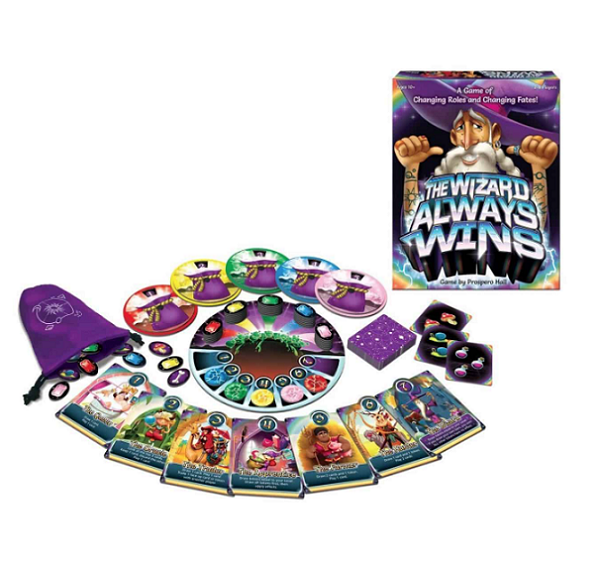The Wizard Always Wins — But the Others Help Him Beat the Odds

All it takes is one gem in the bag to win the game. But the more gems you have in the bag the better your odds of winning. The wizard always wins, but it’s going to take canny use of all the characters if you want to beat the odds.
Designed by Prospero Hall and published by Big G Creative, The Wizard Always Wins is an action selection, push-your-luck game in which players add gems to a token bag and hope to pull their own gem out on a round they’ve selected the wizard.
Gameplay
Each player chooses a player color and takes the matching level dial. Everyone sets their level dials to one. Each player also takes the eight gem tokes in their player color and sets them on the game board. The seven character tiles are then laid out next to the board and each player is dealt three element cards. There are five different types of elements, and each card will show two to three of a single element.
The game board has seven turn order spaces numbered one through seven. During a round, players take turns in order based on which space on the game board their player token is on. On your turn you select one of the seven character tiles and place it in front of you. You then perform the character’s action. These actions will often involve drawing element cards, playing element cards, or drawing tokens from the token bag. The apprentice character lets you draw a number of tokens equal to your level, as does the wizard.
When playing element cards, you place them in front of yourself. You are trying to create sets. After you perform your character’s action you can turn in a set. Four flowers will allow you to increase your level by one, while six bones increases it by two. Five snails let you put one of your gems into the token bag, while eight potions allow you to add two. Finally, seven mushrooms let you increase your level by one and add one gem to the bag.
If you selected the wizard character tile, and you draw a gem in your player color, you win the game; otherwise all tokens you drew are returned to the bag. When you draw tokens as any other character you apply the tokens’ effects. One token type lets you add a gem to the bag, another increases your level. Most tokens show an element. When you draw an element token, you place it in front of yourself and it can be used to create sets. If you draw any gems when not the wizard, they are simply returned to the bag after you finish drawing.
Each character has a number, one through seven (the wizard is number seven). After all players have selected a character and resolved their actions, they place their player tokens on the turn order space whose number matches the characters they chose that round. All characters are then returned to the center of the table and a new round begins.

Review
The Wizard Always Wins is a clever push-your-luck game with an intriguing character choice during each round. The more powerful characters have higher numbers, meaning you’ll go later next round, so you have to decide how important those abilities are to you versus going early next turn. This balance ensures that even when the characters you really want are taken before your turn, there is always something useful for you to do and you never feel like a turn has been wasted. So even at the higher player counts, the game still works well.
Choosing when to start selecting the wizard is also an interesting decision. As long as you have at least one gem of your color in the bag, you could in theory win. Do you start going for the wizard early or try to build up your level and the number of gems in the bag? But while you build up, other players may go for the wizard.
The components are a little bit mixed in quality. The token bag is an unpleasant material, as are the element cards. However, the dials and tiles are all nice and solid and we quite liked the character artwork, while the game’s general aesthetic is really fun and colorful.
This is an easy game to teach, and plays in about twenty to thirty minutes. It’s got a great escalation built in as players level up and start drawing more and more tiles from the bag and more and more player gems are added. Some players might find it frustrating that someone could randomly win quite early on in the game, but in general the push your luck aspect balances nicely with set collection.
Pros: Nice combination of action selection and push your luck, game escalation, aesthetics and artwork
Cons: The game can end abruptly quite early, some of the components could be improved
Disclosure: we received a complimentary review copy of this game.







